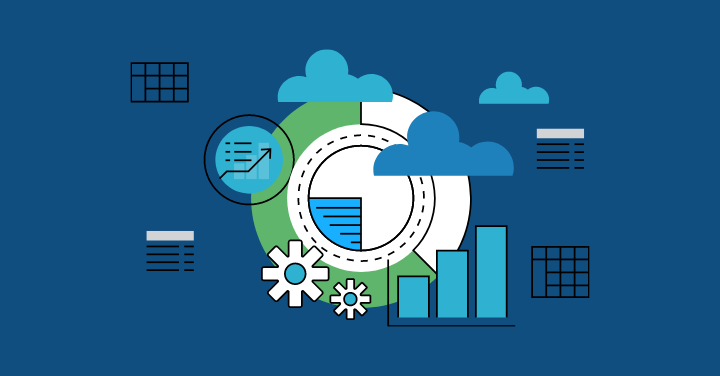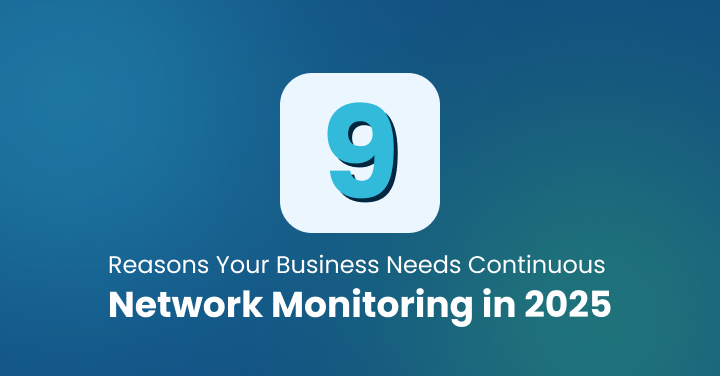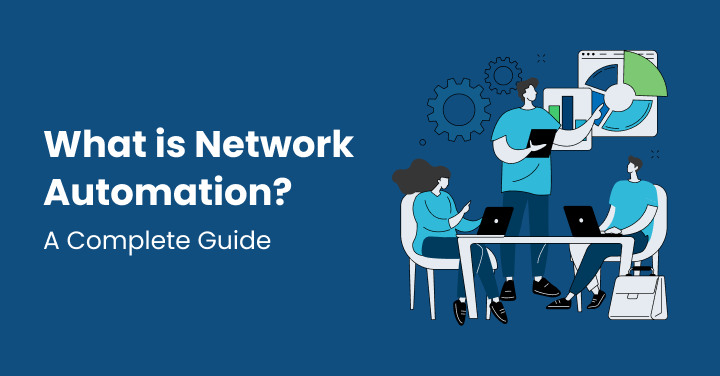Did you know the network infrastructure market revenue is expected to reach YS$253.21bn by the end of 2025? Over the years, small businesses and large organizations have been using networks to communicate and exchange information. With digital transformation and adoption of new technologies, networks are becoming increasingly complex.
Organizations find it challenging to track these complex, extensive networks and identify issues in real time through manual monitoring. Hence, an advanced network monitoring solution has become necessary.
Motadata AIOps is a cutting-edge platform designed to automate network monitoring processes. An organization can enhance its operational efficiency and reduce downtime by leveraging this AI-driven network analytics and automation tool.
Let’s understand more about these challenges and how Motadata AIOps’ powerful solution for network monitoring automation can benefit your organization.
Understanding Network Monitoring Challenges
Today, networks are constantly evolving to accommodate business needs. On one end, where network evolution is beneficial for organizations, on the other end, managing the complexity of these networks with traditional monitoring practices is a big challenge.
Traditional network monitoring systems were designed for more straightforward and more static environments. Scaling organizations that invest a lot of their time and money in advanced technologies struggle to keep up with their business with traditional methods.
Remember, modern networks are no longer confined to on-premises infrastructures but span multiple environments:
Cloud Environment
With the increasing adoption of cloud computing, businesses are migrating workloads to public, private, and multi-cloud environments. Traditional monitoring tools struggle to provide end-to-end visibility across these distributed networks. You might require more advanced network monitoring software to track your cloud performance and ensure security.
Hybrid Infrastructure
Many organizations operate in hybrid environments that combine on-premises data centers with cloud-based services. Monitoring these interconnected systems is another challenge, as various vendors and platforms are involved.
IoT Devices
IoT devices have a wider network, including a vast array of connected devices, sensors, cameras, and smart devices. These devices generate massive amounts of performance data and create potential security vulnerabilities. Using traditional monitoring tools to analyze IoT traffic will not provide the correct information.
Traditional monitoring solutions involve manual configuration and troubleshooting techniques to resolve network issues. This task takes time and is highly likely to result in human error. IT teams may overlook important issues or misconfigured systems that can compromise overall network performance and security.
Further, traditional network monitoring tools cannot manage the rapid growth of these modern infrastructures. Adding new devices and applications can increase the strain on monitoring systems, making tracking and detecting anomalies difficult.
Also, specific traditional monitoring systems operate on a reactive approach,i.e., issues are identified and addressed only after they have occurred.
This may result in network disruption or efficiency reduction. A proactive approach, on the other hand, is powered by real-time analytics and AI-driven insights. It is best to incorporate a proactive network maintenance approach into your business to resolve complex issues.
Implementing traditional practices for modern infrastructure can increase your network downtime, further affecting your financial stability and operational efficiency. Here are the key impacts:
1. Financial Losses
Modern networks are complex; even a minor fault in one area can halt business operations or lead to missed transactions, affecting financial stability. Industries such as e-commerce, banking, and healthcare may face heavy financial losses when their networks go offline, even temporarily.
2. Reputational Damage
A network failure can also damage an organization’s reputation, losing customer trust and confidence. Users’ frequent disruptions might convince them to switch to a more reliable source for quick results.
3. Decreased Productivity
Employees rely on network connectivity to complete tasks, collaborate, and access critical resources. Downtime can disrupt workflows, delay projects, and decrease your overall productivity. Due to network downtime, manufacturing industries, logistics, and financial corporations can have a ripple effect, which may impact supply chains and service delivery.
The Power of Network Monitoring Automation
Traditional monitoring tools might not be able to provide real-time insights and visibility into complex networks, but specific network monitoring automation tools can help achieve your organizational goals. Here are some of the key benefits of leveraging these advanced network monitoring automation tools:
1. Reduced Manual Effort and Operational Costs
Human intervention can cause delays and errors in network performance. However, automating network monitoring eliminates the need for constant manual intervention. This new practice will help reduce the workload on network admins and save time. Automated processes enable IT teams to handle routine monitoring tasks, configuration management, and incident resolution. This leads to lower operational costs as organizations must invest or spend less on labor-intensive monitoring and maintenance.
2. Improved Network Visibility and Real-Time Insights
Automation tools help organizations collect and analyze data from multiple sources in real time. Using these advanced monitoring tools, IT staff can gain deeper visibility into complex networks’ blind spots and track device health and performance trends. Further, the analytical tools help analyze network traffic in real time.
3. Proactive Issue Detection and Resolution
Another advantage of investing in these network monitoring automation tools is that they help team members to track network problems and resolve them before they impact business operations. These AI-driven monitoring tools use predictive analytics to identify potential failures or detect anomalies. Thus allowing IT teams to take preventive action before the problem escalates. This will eventually help reduce network downtime, improve reliability, and enable a better user experience.
4. Enhanced Scalability and Flexibility
Many businesses are using digital platforms and cloud services to expand their business. With organizational expansion, the networks will also grow in size and complexity. The automated network monitoring solutions can scale effortlessly to add new devices and applications. They provide flexibility by adapting to evolving network architectures, including hybrid and multi-cloud deployments.
5. Faster Problem Resolution
Automated network monitoring accelerates troubleshooting by instantly identifying the root cause of issues. With real-time alerts and diagnostic capabilities, IT teams can quickly address the cause behind performance degradation and connectivity issues. Thus enabling faster resolution time.
Core Automation Capabilities in Network Monitoring
1. Automated Discovery and Mapping of Network Devices
A network has various components, including routers, switches, servers, and endpoints. The automated tools help scan these components and generate real-time topology maps. With network mapping, IT teams can gain a visual representation of the entire network. Thus eliminating manual tracking efforts and improving the management of resources.
2. Threshold-Based Alerting and Notifications
Automated monitoring systems define performance thresholds for key network parameters such as bandwidth usage, latency, and packet loss. When these thresholds are exceeded, an alert notifies IT teams to take immediate corrective action. By implementing this strategy, businesses can prevent performance degradation and network outages.
3. Automated Performance Reporting and Analysis
Automated reporting tools generate detailed performance reports, offering insights into network health, usage trends, and potential bottlenecks. Using these reports, it becomes easier to identify long-term patterns and optimize network resources.
4. Automated Root Cause Analysis
The minute your network tracks an issue, the automated systems conduct an in-depth root cause analysis that helps pinpoint the root source of the problem. These tools go through your historical data, logs, and event correlations to provide insightful information on the problem and troubleshoot it faster.
5. Automated Remediation
These tools are not limited to only detection and diagnosis but also initiate corrective actions. For example, if a network device experiences high CPU utilization, the system can automatically adjust configurations or restart processes to restore regular operation. Automated remediation minimizes downtime and enhances network resilience.
Motadata AIOps: A Solution for Network Monitoring Automation
Motadata AIOps is an advanced platform that leverages artificial intelligence (AI), machine learning (ML), and intelligent automation features to enhance network monitoring and IT operations. Some of the key features of Motadata AIOps are:
- AI-driven anomaly detection – Allows IT teams to identify deviations from standard patterns, enabling proactive issue resolution.
- Unified Monitoring Platform—This robust platform consolidates data from various sources and provides comprehensive observability across hybrid and cloud environments.
- Customizable dashboards and reports—IT teams can use this feature to tailor views according to specific operational needs. They can also gain a graphical representation of insights collected after analysis.
- Integration with existing IT infrastructure – It integrates well with third-party tools, cloud services, and existing IT infrastructure to ensure smooth data flow and minimal disruption.
- Log management – The log monitoring and management system facilitates real-time analysis of system data, aiding in quickly identifying trends and potential issues.
Motadata AIOps streamlines operations through automated data collection and analysis, reducing manual intervention and the risk of human error.
Its predictive analytics anticipate potential issues, allowing for proactive maintenance and minimizing downtime. Intelligent alerting helps reduce noise and enables IT teams to focus on critical issues. The platform also automates workflows, enhancing efficiency and ensuring consistent responses to recurring events.
The efficiency gains with Motadata AIOps are significant. Here are some key benefits:
1. Mean Time to Resolution (MTTR) Reduction
With AI-powered anomaly detection and automated incident management, Motadata AIOps helps IT teams identify and resolve issues faster. Thus reducing MTTR and downtime.
2. Increased Network Uptime and Reliability
By proactively detecting issues and automating maintenance tasks, Motadata AIOps ensures higher network uptime. Continuous monitoring and predictive analytics help organizations prevent outages, leading to improved service reliability.
3. Optimized Resource Utilization
The real-time insights into resource consumption enable IT staff to optimize server, storage, and network resources. By balancing workloads efficiently, businesses can reduce costs and improve performance.
4. Improved Overall Performance
With automated monitoring, predictive analytics, and workflow automation, IT teams can focus on strategic initiatives instead of limiting themselves to a specific issue. This leads to better IT service delivery and improved overall business performance.
Implementation and Best Practices
Some of the best practices that an organization must implement for successful network monitoring automation are:
Planning and Preparation
To effectively implement network monitoring automation tools, you must thoroughly plan and prepare yourself. Start with areas you want to monitor, i.e., identifying the key network components such as routers, switches, firewalls, servers, and cloud-based infrastructure. Organizations must also determine the critical performance metrics, including bandwidth utilization, latency, packet loss, and uptime, to ensure comprehensive visibility into network health.
Apart from these, security aspects, such as detecting unauthorized access attempts or abnormal traffic patterns, should be included in the monitoring plan. Once you have finalized key areas that demand monitoring, set up thresholds and alerts. Configure static thresholds for predictable metrics and categorize your alerts by severity to prioritize the most critical issues.
Furthermore, integrating the network monitoring solution well with your existing IT systems enhances efficiency. For instance, linking it with IT service management (ITSM) tools like ServiceNow or Jira streamlines incident handling, while integration with security information and event management (SIEM) platforms strengthens cybersecurity monitoring.
Deployment and Configuration
Another critical aspect that needs your attention is the deployment and configuration of a network monitoring automation system. Select the correct monitoring tool, such as Nagios, Zabbix, SolarWinds, or Datadog, depending on your organization’s requirements and infrastructure. Next, determine whether you want to deploy the solution on-premises or in the cloud. Setting up data collection protocols like SNMP or NetFlow is another crucial step.
Organizations should conduct thorough testing for a seamless rollout by simulating network issues and validating that alerts trigger correctly. Further, check if your tool offers a customizable dashboard and report system that provides real-time network visibility and essential metrics for better decision-making.
Most importantly, role-based access control (RBAC) should be implemented so that different teams can access relevant information while maintaining data security.
Ongoing Monitoring and Optimization
Modern networks need continuous monitoring to reduce downtime and ensure business continuity. Regular reviews and audits will also help IT teams identify bottlenecks and areas for improvement.
By performing monthly trend analyses, IT teams can spot emerging patterns and address potential issues before they escalate. Conducting a thorough analysis of incidents after network disruptions helps refine response time strategies and strengthen system resilience.
Capacity planning is another vital aspect of ongoing optimization. It enables businesses to anticipate infrastructure expansion needs and prevent performance degradation due to increased network load.
Adjust alert configurations based on evolving network patterns and leverage machine learning (ML) models for anomaly detection.
Implementing predictive maintenance models helps organizations proactively address potential hardware failures, reducing downtime. Incorporating Natural Language Processing (NLP) into alert management enables intelligent notification handling, ensuring IT teams focus on high-priority issues.
Conclusion
Investing in Network monitoring automation can help your organization improve efficiency, reduce downtime, and ensure seamless IT operations. The powerful AI-driven monitoring tool can identify and resolve performance issues proactively. Although several network monitoring tools are available in the market, Motadata AIOps plays a crucial role, allowing team members to use AI-driven insights to optimize network performance and minimize disruptions.
As technology evolves, future trends in network monitoring automation will focus on predictive analytics and deeper AI integration. Organizations must embrace these advancements to stay competitive. To achieve operational excellence and stay ahead in the digital landscape, businesses should invest in intelligent network monitoring solutions like Motadata AIOps. If you want to start your journey toward automation today for a more brilliant, more resilient network, click here.
FAQs:
AIOps (Artificial Intelligence for IT Operations) uses AI-driven insights and machine learning techniques to enhance network monitoring, track key metrics, and improve efficiency. It also helps detect issues before they impact performance, thus reducing downtime.
Motadata AIOps provides a real-time topology view by automatically detecting and mapping network devices. It uses different protocols and methods to collect information, map devices, and simplify IT operations.
Yes, it offers real-time network performance insights with monitoring and analytics, which further helps detect issues faster and ensure optimal performance.
Key features of Motadata AIOps include automated discovery, application performance monitoring, IT infrastructure monitoring, cloud network monitoring, log analytics, Incident management automation, AI-driven analytics, and more.
It provides unified visibility across cloud and hybrid infrastructures, ensuring seamless monitoring and management. Its agentless system uses protocols like Secure Shell (SSH) to monitor both on-premises and cloud environments for more insights.







